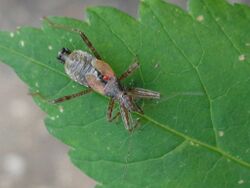Biology:Himacerus apterus
| Tree damsel bug | |
|---|---|

| |
| Himacerus apterus | |
| Scientific classification | |
| Domain: | Eukaryota |
| Kingdom: | Animalia |
| Phylum: | Arthropoda |
| Class: | Insecta |
| Order: | Hemiptera |
| Suborder: | Heteroptera |
| Family: | Nabidae |
| Genus: | Himacerus |
| Species: | H. apterus
|
| Binomial name | |
| Himacerus apterus (Fabricius, 1798)
| |
File:Himacerus apterus in copula - 2012-08-16.ogv Himacerus apterus, known as the tree damsel bug,[1] is a species of damsel bug belonging to the family Nabidae, subfamily Nabinae.
Description
The species is 8–10.5 millimetres (0.31–0.41 in) long for males and 9–11.5 millimetres (0.35–0.45 in) for females.[2] It has black connexivum and orange-red spots with reddish-brown wings.[1] It wingspan is 8–10 millimetres (0.31–0.39 in)
Distribution
It is found in most of Europe[3] and southern and central Asia.[4] Between 1943 and 1989 the species was found in eastern Nova Scotia.[5]
Diet
The species feeds on mites, aphids and other small insects.[1]
Ecology
Adults lay eggs in late summer on plant stems which hatch in spring.[4] Larvae is found from May to August.[1]
References
- ↑ 1.0 1.1 1.2 1.3 "Himacerus apterus". British Bugs. http://www.britishbugs.org.uk/heteroptera/Nabidae/himacerus_apterus.html. Retrieved June 22, 2013.
- ↑ "Size by gender". Commanster. http://www.commanster.eu/commanster/Insects/Bugs/SuBugs/Himacerus.apterus.html. Retrieved June 23, 2013.
- ↑ "Himacerus (Himacerus) apterus (Fabricius, 1798)". Fauna Europaea. August 29, 2013. http://www.faunaeur.org/full_results.php?id=452529. Retrieved October 13, 2013.
- ↑ 4.0 4.1 "Himacerus apterus". http://toutunmondedansmonjardin.perso.neuf.fr/EN/pages_EN/himacerus_apterus_EN.htm. Retrieved June 23, 2013.
- ↑ Marie-Claude Lartvière (August 1992). "Himacerus apterus (Fabricius), A Euroasian Nabidae (Hemiptera) New to North America: Diagnosis, Geographical Distribution, and Bionomics". Canadian Entomologist (Cambridge University Press) 124 (4).
External links
Wikidata ☰ Q811622 entry
 |

